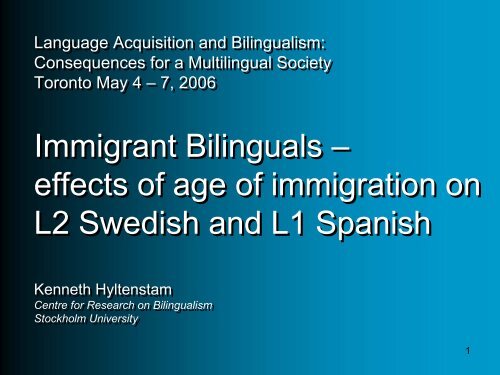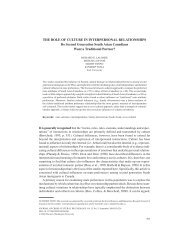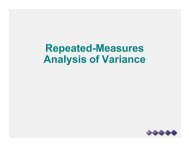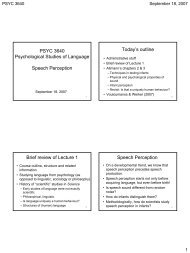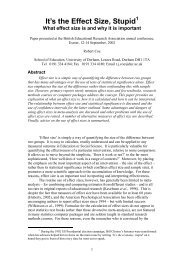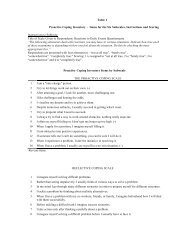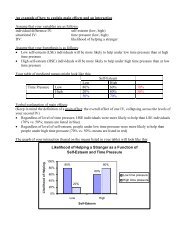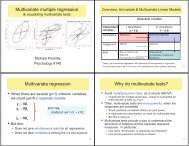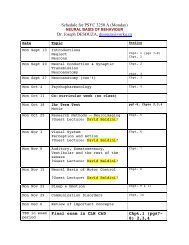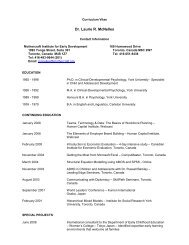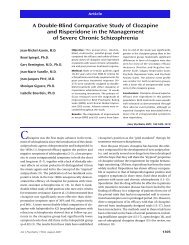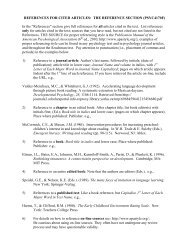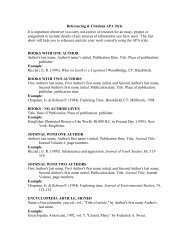Kenneth Hyltenstam
Kenneth Hyltenstam
Kenneth Hyltenstam
You also want an ePaper? Increase the reach of your titles
YUMPU automatically turns print PDFs into web optimized ePapers that Google loves.
Language Acquisition and Bilingualism:<br />
Consequences for a Multilingual Society<br />
Toronto May 4 – 7, 2006<br />
Immigrant Bilinguals –<br />
effects of age of immigration on<br />
L2 Swedish and L1 Spanish<br />
<strong>Kenneth</strong> <strong>Hyltenstam</strong><br />
Centre for Research on Bilingualism<br />
Stockholm University<br />
1
Immigration to Sweden<br />
• 1940s, 1950s: Waves of refugees, incipient labour<br />
immigration from neighbouring countries<br />
• 1960s: labour immigration from southern and central<br />
Europe<br />
• 1970-: refugees, family connection cases<br />
Today<br />
≈12 % of the population of 9 million<br />
Most common countries of origin:<br />
Finland, former Yugoslavia, Iran, Norway, Iraq<br />
Most commonly spoken lgs of immigrant pupils: Arabic,<br />
Finnish, Spanish, Albanian, Persian<br />
2
Bilingualism at school<br />
• Right to mother tongue instruction since<br />
1977; ≈ 50 % participate at their own<br />
choice<br />
• Swedish as a second language since 1966<br />
• Implementation problems are salient.<br />
3
Age of onset and ultimate attainment in<br />
second language acquisition<br />
(The Bank of Sweden Tercentenary Foundation)<br />
<strong>Kenneth</strong> <strong>Hyltenstam</strong> (PI, project leader)<br />
Niclas Abrahamsson (PI)<br />
Katrin Stölten (SI, PhD student)<br />
Johan Roos, Gunilla Thunberg (assistants)<br />
First Language Attrition in Advanced Second<br />
Language Learners<br />
(The Swedish Research Council)<br />
Niclas Abrahamsson (PI, project leader)<br />
<strong>Kenneth</strong> <strong>Hyltenstam</strong> (PI)<br />
Emanuel Bylund, Katrin Stölten<br />
(SI, PhD students)<br />
Alejandra Donoso (assistant)<br />
4
Questions for this talk<br />
1. What is the rate of ”complete” SL acquisition among late learners?<br />
(Selinker, 1972: 5 %; Birdsong, 1999, 2005: 15%; Piller, 2005:<br />
45%; Bley-Vroman, 1989: 0 %)<br />
2. What is the rate among prepuberty learners? (<strong>Hyltenstam</strong>, 1992;<br />
Tsukada, Birdsong, Bialystok, Mack, Sung & Flege, 2005)<br />
3. What is the rate perceived nativelikeness?<br />
4. What is the rate of scrutinized nativelikeness?<br />
5. To what extent are these rates related to certain age of aquisition<br />
spans? Correlations with other background factors?<br />
6. Do patterns of L1 use correlate with degree of perceived or<br />
scrutinized nativelikeness in L2? (Flege et al. 1995; Pallier et al.<br />
2003; Ventureyra et al. 2004)<br />
5
Methodological outline<br />
1. Identification of candidates for nativelikeness<br />
2. Screening for nativelikeness<br />
3. Many complex tests and detailed analyses of<br />
nativelikeness<br />
6
Identification of nativelike candidates<br />
Advertisement 1 in Metro 16 September 2002<br />
125×182 mm<br />
• 135 candidates<br />
625 000–720 000<br />
readers per day<br />
Advertisement 2 in Metro 16 April 2003<br />
125×182 mm<br />
• 50 candidates<br />
Advertisement 3 in Aftonbladet<br />
15 March 2004, 250×100 mm<br />
• 10 (!) candidates<br />
325 000 readers per day<br />
7
Identification of nativelike candidates<br />
Six selection criteria:<br />
1. L1: Spanish<br />
2. speak Swedish like a native speaker<br />
3. ≥ 19 years old<br />
4. length of residence in Sweden: ≥ 10 years<br />
5. 12 years of education (minimum)<br />
6. speak the Stockholm variety of Swedish<br />
8
Telephone interview (recorded)<br />
Age of onset (AO) of acquisition of Swedish<br />
Present age (AGE)<br />
Length of residence (LOR) in Sweden<br />
Pattern and frequency of use of Spanish and Swedish<br />
Knowledge of other languages<br />
Longer periods away from Sweden / the Stockholm area<br />
Any known hearing impairment or dyslexia<br />
Handedness<br />
9
Speech elicitation<br />
Describe Astrid Lindgren and<br />
her books and characters for<br />
about one minute<br />
10
Background variables<br />
Background information (independent variables) on the 195 candidates; comparison<br />
between those with AO before and after puberty (df = 193).<br />
AO ≤ 11 years<br />
(n = 107)<br />
AO ≥ 12 years<br />
(n = 88)<br />
t-test<br />
Independent variable<br />
M<br />
SD<br />
M<br />
SD<br />
t<br />
p<br />
Chronological age<br />
28,6<br />
7,2<br />
41,5<br />
9,1<br />
–11.1<br />
< .0001<br />
Years in Sweden<br />
23,1<br />
7,5<br />
21,2<br />
7,3<br />
1.82<br />
> .071ns<br />
Years of L2 exposure<br />
22,4<br />
7,4<br />
20,9<br />
7,3<br />
1.41<br />
> .1, ns<br />
Daily L1 use (%)<br />
27,4<br />
17,5<br />
30,9<br />
18,1<br />
–1.34<br />
> .1, ns<br />
Sex (f/m)<br />
69/31<br />
61/39<br />
–1.14<br />
> .1, ns<br />
11
Screening experiments<br />
Three computerized screening experiments<br />
The first 20–30 sec. of the Astrid Lindgren descriptions<br />
… and descriptions over the telephone from 20 native<br />
speakers of Swedish (10 from Stockholm, 10 with subtle<br />
non-stockholmian features in their pronunciation)<br />
10 native Swedish judges per experiment (not linguists,<br />
phoneticians, etc.; no knowledge of Spanish)<br />
C. 45-90 minutes, SEK 100–150:- (≈ $13 – 20)<br />
12
Screening experiments<br />
I believe that this person:<br />
A. has Swedish as a mother tongue<br />
and comes from Stockholm<br />
B. has Swedish as a mother tongue<br />
but does not come from Stockholm<br />
C. has another mother tongue than<br />
Swedish<br />
13
Screening experiments<br />
Scoring:<br />
- Alternatives A and B = speaks Swedish as a<br />
native speaker<br />
- Alternative C = does not speak Swedish as a<br />
native speaker<br />
Degree of perceived nativelikeness (DPN) = the<br />
number of judges who chose alternative A or B<br />
14
Listening experiments<br />
L2<br />
+ L1<br />
Experiment 1: 135 + 20 = 155<br />
Experiment 2: 50 + 8 = 58<br />
Experiment 3: 40+10 + 8 = 58<br />
Interrater reliability: r = .97, df = 38, p < .001<br />
15
Screening results<br />
16
Degree<br />
Degree<br />
of<br />
of<br />
perceived<br />
perceived<br />
nativelikeness<br />
nativelikeness<br />
(DPN,<br />
(DPN,<br />
max.<br />
max.<br />
10)<br />
10)<br />
10<br />
10<br />
9<br />
9<br />
8<br />
8<br />
7<br />
7<br />
6<br />
6<br />
5<br />
5<br />
4<br />
4<br />
3<br />
3<br />
2<br />
2<br />
1<br />
1<br />
0<br />
0<br />
F(5, 209) = 67.40, p < .0001<br />
Native<br />
Native<br />
Early<br />
Early<br />
Late<br />
Late<br />
Adolescence<br />
Adolescence<br />
speakers<br />
speakers<br />
childhood<br />
childhood<br />
childhood<br />
childhood<br />
AO<br />
AO<br />
12-17<br />
12-17<br />
AO<br />
AO<br />
Individual screening results<br />
18
DPNs among 195 candidates<br />
19
Individual screening results<br />
20
Individual screening results<br />
21
Main subjects: : 41<br />
Additional subjects: : 24<br />
22
Background variables, main<br />
subjects<br />
23
Control subjects<br />
15 native speakers of Stockholm Swedish …<br />
… who were not linguists, phoneticians,<br />
students of Swedish or modern languages, etc.<br />
Matched for age, sex, and education<br />
24
Tests and instruments<br />
• Background interview + self assessments (L1 and L2)<br />
• Hearing test (w. tone audiometer)<br />
• Language learning aptitude test (5 subtests)<br />
• Voice onset time (VOT): production of /p t k/ and /b d g/<br />
• Voice onset time (VOT): categorical perception of /p-b/, /t-d/, and /k-g/<br />
• Word perception in babble noise<br />
• Sentence perception in white noise<br />
• Grammaticality judgment test (GJT), presented in writing<br />
• Grammaticality judgment test (GJT), presented auditorily (w. RTs)<br />
• Proverbs<br />
• Idiomatic expressions<br />
• Cloze test<br />
• Production (four modalities: word list, sentences, text, picture story)<br />
• First 15 minutes of Modern Times (online + retelling)<br />
25
Testing procedure<br />
Subjects were tested individually in a sound<br />
treated room<br />
Experimenter: male native speaker of Swedish<br />
Ca. 4 hours, including two 15-minute breaks with<br />
sandwich, fruit and refreshments<br />
Compensation: SEK 500:- (ca. €50,-)<br />
26
Native speaker ranges<br />
27
Results within native speaker ranges on 10<br />
measures<br />
28
Korrelations L1 use patterns and<br />
perceived nativlikeness among 195<br />
subjects (Pearson’s r)<br />
All subjects -.25**<br />
AO ≤ 11 -.34**<br />
AO ≥ 12 -.14<br />
29
Adoptees<br />
4 subjects, 3 measures<br />
Cloze Idioms Proverbs<br />
Max 42 50 50<br />
NS 30-41 33-48 33-46<br />
AO<br />
1 36 44 42<br />
2 34 42 40<br />
4 27 29 32<br />
9 13 21 21<br />
30
Tests and instruments<br />
The Age of Onset Project (L2 Swedish)<br />
Telephone interview + self<br />
assessments on L1 och L2<br />
Hearing test<br />
Language Aptitude Test (5 parts)<br />
Repetion in ”babble noise”<br />
Grammaticality Judgment (written)<br />
Grammaticality Judgment (auditory)<br />
Repetion in white noise<br />
Cloze test<br />
Production (four mod.)<br />
Proverbs<br />
Idiomatic expressions<br />
VOT: production of /p t k b d g/<br />
VOT: categorical perception<br />
Modern Times (online + retell.)<br />
–<br />
–<br />
–<br />
The Attrition Project (L1 Spanish)<br />
Detailed questionnaire on L1 use<br />
–<br />
–<br />
–<br />
–<br />
GJ (auditory)<br />
Repetition in white noise<br />
Cloze test<br />
Production (four mod.)<br />
Proverbs<br />
Idiomatic expressions<br />
VOT: production of /p t k b d g/<br />
VOT: categorical perception<br />
Modern Times (online + retell.)<br />
Quest, retelling<br />
Verbalisation of single events<br />
2 tense-aspect judgment tests<br />
31
Korrelation between GJ Spanish<br />
and age at break with L1 majority<br />
commnity<br />
Main group + controls<br />
Main group<br />
100<br />
95<br />
90<br />
100<br />
95<br />
90<br />
85<br />
85<br />
80<br />
80<br />
GJ<br />
75<br />
GJ<br />
75<br />
70<br />
70<br />
65<br />
65<br />
60<br />
60<br />
55<br />
55<br />
50<br />
0 5 10 15 20<br />
AO<br />
50<br />
0 5 10 15 20<br />
AO<br />
r = 0,440778<br />
p =
Correlation GJ Spanish - Swedish<br />
GJ<br />
100<br />
90<br />
80<br />
Spanish<br />
70<br />
60<br />
50<br />
40<br />
30<br />
30 40 50 60 70 80<br />
Sw edish<br />
Korr.<br />
r = 0,463064,<br />
p
Correlation Cloze Spanish - Swedish<br />
Cloze<br />
45<br />
40<br />
35<br />
Spanish<br />
30<br />
25<br />
20<br />
15<br />
10<br />
10 20 30 40 50<br />
Sw edish<br />
r = 0,565232<br />
p
Summary<br />
1. A majority of the 107 pre-puberty learners were perceived as nativelike; 6<br />
% by only 1 or 0 judges.<br />
2. Most of the the 88 late learners were not perceived as nativelike, but 6 %<br />
of them passed for native speakers by 9 or 10 judges. However, a) the<br />
present subjects were heavily selected, b) only subjects with AO 12-17<br />
(no subject among the 57 candidates with an AO beyond 17), and c) the<br />
sample the judges had to assess was 20-30 seconds long.<br />
3. Only two, possibly three, of 41 learners had a scrutinized nativelikeness<br />
on all ten measures of proficiency. One post-puberty learner was within<br />
the range of native controls on 7 and another one on 6 measures.<br />
4. AO is the strongest predictor of both perceived and scrutinized<br />
nativelikeness.<br />
5. Patterns of L1 use correlates only weakly with degree of perceived or<br />
scrutinized nativelikeness. Indications that loss of L1 does not promote<br />
nativelikeness, and that L1 proficiency level is not inversely related to L2<br />
proficiency level.<br />
35
Consequences for a multilingual<br />
society<br />
• Teaching and other support for second<br />
language acquisition should aim at an<br />
effective and functional SL proficiency.<br />
• Nativelike SL proficience a questionable<br />
and in many cases unrealistic goal.<br />
• Support for L1 development need not be<br />
sacrificed on the alter of nativelikeness.<br />
36


